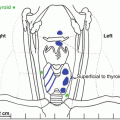Differential diagnosis
PTH excess
Malignancy
Non-PTH endocrine causes
Granulomatous disease
Medications
Miscellaneous
PHPT
Parathyroid adenoma
Parathyroid carcinoma
Multiglandular hyperplasia as part of MEN syndromes (MEN1 and 2A)
FIH
HPT-JT
HHM
PTHrP (80 %)
1,25-(OH)2D (<1 %)
PTH (<1 %)
Bone mets/local osteolysis (20 %): cytokines, local PTHrP
Thyrotoxicosis
Adrenal insufficiency
Pheochromocytoma
VIPoma
Acromegaly
Sarcoidosis
Tuberculosis
Coccidioidomycosis
Histoplasmosis
Blastomycosis
Berylliosis
Leprosy
Crohn’s disease
Lithium
Thiazides
Vitamin D intoxication
Excessive vitamin A
Teriparatide
Theophylline toxicity
Milk-alkali syndrome
Immobilization
Parenteral nutrition
FHH (UCCR <0.01)
Tertiary HPT (renal failure)
The patient was found to have a mildly increased ACE level of 60.9 units/L (normal, 8–53), negative fungal serologies, and negative PPD skin test. These findings were interpreted as suggesting the patient had coexisting sarcoidosis with her PHPT. ACE levels, although nonspecific, are useful in conjunction with other diagnostic procedures such as bronchoscopic needle biopsy, or biopsy of other accessible tissue such as bone marrow, with pathology showing noncaseating granulomas. The patient underwent bronchoscopic needle biopsy of one of her mediastinal lymph nodes, with her pathology report noting noncaseating granulomas, consistent with sarcoidosis.
A large health maintenance organization-based study estimated the annual incidence of sarcoidosis in Caucasians at 9.6 per 100,000 person-years and in African Americans at 35.5 per 100,000 person-years [25]. A Rochester Epidemiology Project population-based study in Rochester, Minnesota, estimated the annual incidence of sarcoidosis at 6.1 per 100,000 person-years [26]. Another Rochester Epidemiology Project population-based study indicated that the annual incidence of PHPT ranged between 15.8 and 129 per 100,000 person-years over 30 years, depending on the year incidence was assessed [1].
Patients may be suspected of having two coexisting causes of hypercalcemia, with PHPT often being the easier of the two to recognize. The first cases of coexisting PHPT and sarcoidosis were reported in 1958 [27]. Since then there have been mostly case reports or small case series of these coexisting disorders [28–30]. Evaluation of a recent large cohort of 50 patients with coexisting PHPT and sarcoidosis reported from the Mayo Clinic in Rochester, Minnesota [31], showed that patients with PHPT who had active sarcoidosis had higher serum ACE levels (60.9 ± 38.1 vs. 20.2 ± 14.0 units/L, P-value <0.0001), lower PTH levels (60 ± 24 vs. 96 ± 41 pg/mL, P-value 0.01), and lower phosphorus levels (2.7 ± 0.6 vs. 3.2 ± 0.5 mg/dL, P-value 0.02) than patients with PHPT alone. Reports of coexisting PHPT and secondary causes of hypercalcemia other than malignancy are less common.
Management
Recognition of the additional diagnosis of coexisting sarcoidosis, which was made evident after parathyroidectomy, led to treatment of the patient with prednisone 20 mg each day for 1 month, with rapid normalization of her serum calcium and a trend toward normalization of her serum phosphorus during her first week of treatment. Her prednisone was gradually tapered over the next 4 months, with persistently normal serum calcium.
Outcome
The patient was followed every 6 months for the next 5 years without recurrence of either her PHPT or sarcoidosis. Other patients may develop recurrence of either or both disorders in time.
Clinical Pearls/Pitfalls
Age, gender, and magnitude of hypercalcemia should be considered, as well as variation in serum PTH, calcium, phosphorus, and 1,25-dihydroxyvitamin D levels and patient context, when assessing possible etiologies of hypercalcemia.
When coexisting causes of hypercalcemia are suspected or known to be present, classical findings of PHPT should not be expected.
When faced with the possibility of coexisting causes of hypercalcemia, the clinical approach should be tailored to the patient after analyzing all available laboratory and imaging data.
Patients presenting with hypercalcemia may have several causes contributing to their hypercalcemia. Dehydration, renal insufficiency, or vitamin D or A excess, in addition to increased PTH or granulomatous overproduction of 1,25-dihydroxyvitamin D, may all contribute to hypercalcemia in the same patient. The challenge for the clinician is to tease out the major cause or causes of hypercalcemia.
Consideration of the complete differential diagnosis of hypercalcemia in each case is important since different causes of increased serum calcium levels are treated in distinctive ways.
Conflict of Interest
All authors state that they have no conflicts of interest.
References
1.
2.
Christensen SE, Nissen PH, Vestergaard P, Mosekilde L. Familial hypocalciuric hypercalcaemia: a review. Curr Opin Endocrinol. 2011;18:359–70.CrossRef






